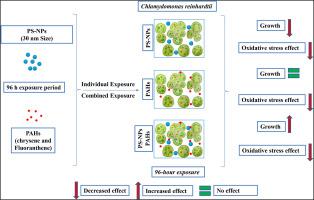Aquatic Toxicology ( IF 4.5 ) Pub Date : 2024-01-12 , DOI: 10.1016/j.aquatox.2024.106838 Gopi Narayanan , Mohmmed Talib , Nisha Singh , Gopala Krishna Darbha

|
While the toxicity of nano-microplastics and polycyclic aromatic hydrocarbons (PAHs) to aquatic organisms is well-studied, their joint impact on microalgae is less explored. This study focused on single and combined effects of PS-NPs (30 nm; concentrations: 2, 5, 10, and 25 mg/L) and two PAHs (chrysene and fluoranthene at 10, 100 µg/L) for 96 h on the accumulation, growth, photosynthetic parameters, and oxidative stress in the Chlamydomonas reinhardtii. The findings revealed that exposure to increasing concentrations of PS-NPs significantly reduced the growth inhibition ratio and chlorophyll-a content after 96 h. Both PAHs (100 µg/L) + PS-NPs (25 mg/L), significantly reduced the growth inhibition ratio and chlorophyll-a levels. Individual and combined exposures of PS-NPs and PAHs can prompt antioxidant responses like SOD, GPx, and GST, as well as an unaffected level of non-enzymatic antioxidant GSH and diminished CAT activity. Furthermore, both PAHs + PS-NPs triggered ROS levels, resulting in cell membrane damage. However, the reduced oxidative effect of LPO of combined exposures can be attributed to the activation of antioxidant defenses. In addition, the microscopic visualization data shows that PS-NPs adhered to the surface of microalgae. Also, PS-NPs reduced the adsorption of PAHs on the surface of C. reinhardtii. Altogether, this study implied that the influence of coexistent PS-NPs should be considered in the environmental risk assessment of PAHs in aquatic environments.
中文翻译:

聚苯乙烯纳米塑料和多环芳烃(蒽和荧蒽)对莱茵衣藻生长和生理特性的毒性作用
虽然纳米微塑料和多环芳烃 (PAH) 对水生生物的毒性已得到充分研究,但它们对微藻的共同影响却很少被探讨。本研究重点关注 PS-NP(30 nm;浓度:2、5、10 和 25 mg/L)和两种 PAH(10、100 µg/L 的屈蒽和荧蒽)96 小时对莱茵衣藻的积累、生长、光合参数和氧化应激。结果表明,暴露于浓度不断增加的 PS-NP 中96 小时后,生长抑制率和叶绿素a含量显着降低。PAHs (100 µg/L) + PS-NPs (25 mg/L) 均显着降低了生长抑制率和叶绿素-a水平。PS-NP 和 PAH 的单独和组合暴露可促进 SOD、GPx 和 GST 等抗氧化反应,以及不受影响的非酶抗氧化剂 GSH 水平和 CAT 活性降低。此外,PAHs + PS-NPs 都会触发 ROS 水平,导致细胞膜损伤。然而,联合暴露的 LPO 氧化作用降低可归因于抗氧化防御的激活。此外,显微可视化数据显示 PS-NP 粘附在微藻表面。此外,PS-NPs 还减少了莱茵衣藻表面 PAH 的吸附。总之,这项研究表明,在水生环境中 PAH 的环境风险评估中应考虑共存 PS-NP 的影响。



























 京公网安备 11010802027423号
京公网安备 11010802027423号